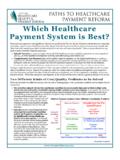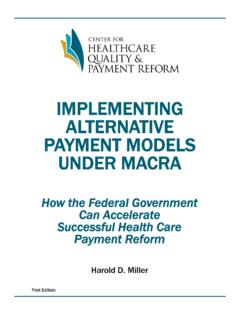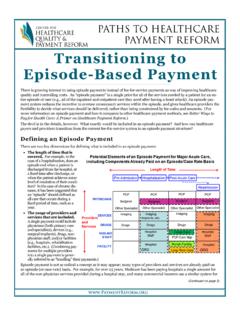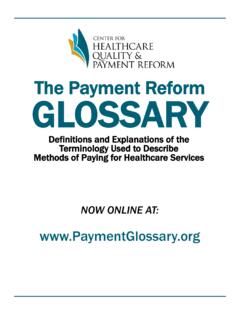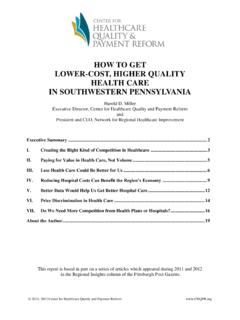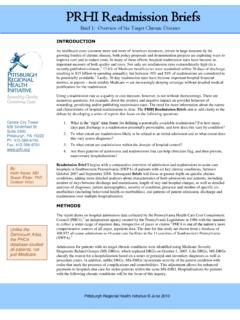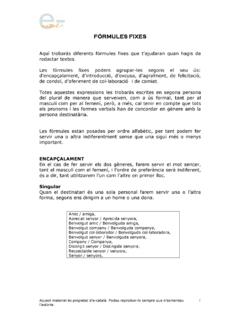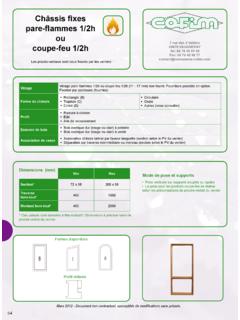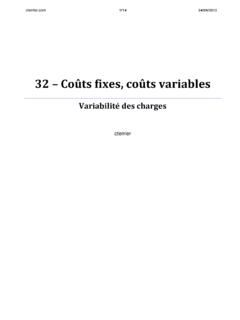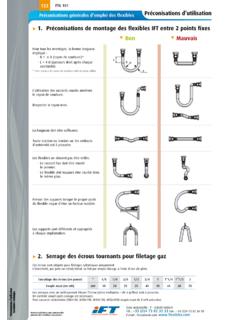Transcription of Physician-Focused Alternative Payment Models
1 A GUIDE TO. Physician-Focused . Alternative Payment . Models . Better Care for Patients Financially Lower Viable Spending physician for Payers Practices Better Care for Patients CONTENTS Financially Viable physician Lower Spending for Payers Practices EXECUTIVE i I. THE NEED FOR Physician-Focused Alternative Payment Models .. 1. A. Barriers to Better Care and Lower Costs in Current Payment 1. B. Characteristics of Successful Alternative Payment Models .. 1. C. Creating Physician-Focused APMs in Medicare .. 2. II. A MENU OF Physician-Focused Alternative Payment Models .
2 3. APM #1: Payment for a High-Value Service .. 5. APM #2: Condition-Based Payment for a physician 's Services .. 7. APM #3: Multi- physician Bundled Payment .. 9. APM #4: physician -Facility Procedure 11. APM #5: Warrantied Payment for physician Services .. 13. APM #6: Episode Payment for a Procedure .. 15. APM #7: Condition-Based Payment .. 17. III. CHOOSING AN APPROPRIATE Alternative Payment model .. 19. A. Matching the APM to Opportunities, Barriers, and Capabilities .. 19. B. Combining Multiple APMs .. 19. C. Using APMs for Provider Compensation Inside of Other APMs.
3 19. American Medical Association and Center for Healthcare Quality and Payment Reform 2. Better Care A Guide to Physician-Focused for Patients Alternative Payment Models Financially Viable Lower Spending EXECUTIVE SUMMARY physician Practices for Payers The Barriers in Current Payment Systems defining APMs so that they can support the wide range of to Higher-Value Healthcare health problems physicians treat. All too often, when physicians try to redesign the ways they deliver services in order to provide higher quality patient A Menu of Physician-Focused care at a lower cost , they find that barriers in current pay- ment systems prevent them from doing so.
4 The two most Alternative Payment Models common barriers are: There is no single approach to APMs that will work for all Lack of Payment or inadequate Payment for high- physicians or their patients. Different medical specialties value services. Medicare and most health plans do not treat different kinds of health problems, and the opportuni- pay physicians for many services that would benefit ties to improve quality and reduce costs differ by the differ- patients and help reduce avoidable spending. ent types of health problems addressed by physicians with- in each specialty and subspecialty.
5 Moreover, the care Financial penalties for delivering a different mix of delivery changes that are needed to address these services. Under fee for service (FFS), practices lose opportunities also differ by specialty, as do the barriers in revenue if physicians perform fewer or lower-cost the current Payment system that need to be overcome for services, but their practice costs do not decrease propor- physicians to redesign care delivery for their patients. tionately (if at all), which can cause operating losses. This report describes seven ways of structuring APMs that can be used to address the most common types of Alternative Payment Models Can Enable opportunities and barriers that physicians face: APM #1.
6 Payment for a High-Value Service. A physician Higher Quality and Lower Costs practice would be paid for delivering one or more Alternative Payment Models (APMs) can provide a way of desirable services that are not currently billable, and the overcoming the barriers in current Payment systems so that physician would take accountability for controlling the physicians can deliver higher-quality care for patients at use of other, avoidable services for their patients. lower costs for purchasers in ways that are financially APM #2.
7 Condition-Based Payment for physician feasible for physician practices. To be successful, an APM Services. A physician practice would have the must have three characteristics: flexibility to use the diagnostic or treatment options that 1. Flexibility in Care Delivery. An APM must be designed address a patient's condition most efficiently and to give physicians sufficient flexibility to deliver the effectively without concern that using lower-cost services patients need in the most efficient and effective options would harm the operating margins of the way possible.
8 physician 's practice. 2. Adequacy and Predictability of Payment . An APM APM #3. Multi- physician Bundled Payment . Two or must provide adequate and predictable resources to more physician practices that are providing complemen- enable physician practices to cover the costs of delivering tary diagnostic or treatment services to a patient would high-quality care to patients. payments must be appro- have the flexibility to redesign those services in ways priately risk-adjusted based on characteristics of patients that would enable high-quality care to be delivered as that increase their need for services, and limits must be efficiently as possible.
9 Placed on the total amount of financial risk that APM #4. physician -Facility Procedure Bundle. physicians face. A physician who delivers a procedure at a hospital or 3. Accountability for Costs and Quality That Physicians other facility would have the flexibility to choose the Can Control. An APM must also be explicitly designed most appropriate facility for the treatment and to work to assure patients and payers that spending will be with the facility to deliver the procedure in the most controlled or reduced and that quality will be maintained efficient and high-quality way.
10 Or improved. However, individual physicians should only APM #5. Warrantied Payment for physician Services. be held accountable for aspects of spending and quality A physician would have the flexibility and accountability they can control or influence. to deliver care with as few complications as possible. The Medicare Access and CHIP Reauthorization Act (MACRA) APM #6. Episode Payment for a Procedure. A physician encourages the creation of APMs and provides incentives for who is delivering a particular procedure could work physicians to participate in them.
